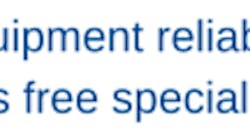One of the greatest tools any maintenance person can rely on is the equipment operator. As an asset management technician, I create equipment maintenance plans based on FMEAs. I can look at the possible failures of a piece of equipment and tell if we need to create predictive maintenance (PdM) or inspection tasks to prolong its life cycle.
Many of these plans are based on time or cycles: change the oil every four months or grease the bearings after 200 hours of run time. A lot of the PdM tasks are also time-based: use vibration analysis every four months or monthly, depending on the trending patterns of the equipment. There are also condition-based tasks that depend on readings or analysis of PdMs.
As I watched the last NASCAR race I thought about how the crew chief sets the car up according to his plan for the type of track, the distance of the race, the weather factors, and the style of the driver. The real information comes from the driver, or the operator.
Just listen on the radio: “The car is tight in the corner and loose off the straight. I have a vibration in the rear quarter panel.”
With this information the crew chief directs the pit crew, “Adjust the air pressure in the next set of tires to stop the tightness in the corners, and get the wrench set to put a round of wedge in the right side to stop the looseness on the straight. And get the right rear tire changer to be sure all the lug nuts are tight.”
This communication is vital for the team to have a winning car, and it’s the same for any company’s equipment. The maintenance department has their list of PMs, PdMs, and inspections that get printed out of the CMMS at the time-based intervals or on a condition-based period. These items are important to the reliability of the equipment. But it’s the operator who spends their shift with the equipment as they perform their job. It’s the operator who would hear or feel a possible problem with that equipment.
Robert Glancy is an asset management technician at Life Cycle Engineering. Robert works with clients to improve and optimize their manufacturing operations by improving the reliability and availability of their process equipment. Robert can be reached at [email protected].
If the operator is really interested in how the machine was designed and how it was intended to be operated and maintained, the operator can volunteer to become part of a reliability-centered maintenance (RCM) or total productive maintenance (TPM) team. Both of these maintenance approaches take operators to the next level. For example, operators who have participated in RCM analyses for critical machines report they better understand how the equipment was designed to work and why it was critical to inspect and record things like pressures, temperatures and flows on each machine. Creating a minor checklist for the operator to note any changes in the equipment gives the maintenance department a heads-up on impending problems.
As a crane operator, I always performed my pre-lift checklist. I would check the battery load, check the site-glass on the hydraulic system, note the fluid temperatures, inspect the wire rope and finally check that the hook and lifting devices were all in good condition so that I could perform my job safely and without a breakdown. Communication between the operators and the maintenance department is a vital link to the reliability of all the equipment.
So build your team, create your plan, make sure your team communicates well, and rev your engines to win the race to real reliability!

